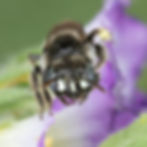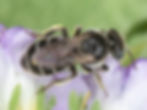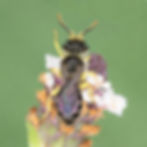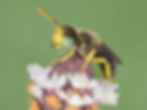SHARP-EATMAN
NATURE
PHOTOGRAPHY
ID GUIDE TO WILD BEES
OF THE NATIONAL BUTTERFLY CENTER
Mission, Texas

MINER BEES
Calliopsis
MINER BEES
Genus Calliopsis
Calliopsis are small to very-small, usually darkly-colored bees with pale markings. Females tend to be stoutly-built with small pale markings on the face and legs. Males have slenderer builds and more extensive pale or yellowish coloration on the face, antennae and legs.
Calliopsis are found only in the Western Hemisphere. Within the United States, Calliopsis are most common and most diverse in the southwest and west. Calliopsis is the sole genus of its tribe Calliopsini in North America.
Calliopsis behavior
Like the Protandrena and Perdita shown in this guide's preceding sections, Calliopsis are miner bees belonging to the subfamily Panurginae. Calliopsis are solitary ground-nesters that sometimes form populous aggregations. Nonetheless, the small nest-entrances of these tiny bees may be difficult to find because Calliopsis nests tend to be well-hidden. Calliopsis females have been observed plugging their nest holes with soil or sand and later “swimming” through the plugs to reach their underground nest tunnels.
Some Calliopsis females exude a smell that entomologist Alvin Shinn described in 1967 as reminiscent of lemongrass. He speculated that the bees used the scent in order to mark and locate their nest entrances.
The behavior of Calliopsis males is also singular. Entomologist William T. Wcislo reported that male Honduran calliopsis sleep in shallow burrows, which they dig near areas where female bees are nesting. During the day, males stake out territories near nests and chase away other Calliopsis hondurasica males, and sometimes other insects as well.
Male Honduran calliopsis sometimes engage in dog-fighting behavior. Wcislo described male Calliopsis hondurasica engaging in a practice he called “spiral flight”: pairs of males faced off, jostling each other and flying rapidly in an increasingly-tight vertical spiral to a height of about one meter. Eventually, one male would grab the other, making both crash to the ground, where they tumbled and wrestled, sometimes biting each other on the legs until the bee defending the territory prevailed and the intruder caved and fled – or until the intruder successfully evicted the territory holder and took up residence.
Floral preferences of Calliopsis
Calliopsis may be generalist pollinators, or roughly oligolectic, gathering pollen from a narrow spectrum of plants. The Honduran calliopsis featured here has been found on a range of plants in Mexico and Central America. In the Lower Rio Grande Valley, it is found most often on small-flowered plants, and it is closely associated with the purple-flowered ground-cover known as Nama.

A male Honduran calliopsis
TRAITS OF CALLIOPSIS

A female Calliopsis on the head of a dime: Calliopsis are small to very-small bees.

Female Calliopsis of the Valley tend to be robustly-built, with predominantly dark bodies.

Female Calliopsis often have small pale markings on their faces.

Nama, a flower native to the Valley that attracts Honduran calliopsis
TAXONOMY OF CALLIOPSIS
Order: Hymenoptera
Family: Megachilidae
Subfamily: Panurginae
Tribe: Calliopsini
Genus: Calliopsis
Species shown on this page:
Calliopsis (Calliopsis) hondurasica
(Honduran calliopsis)
Honduran Calliopsis
Calliopsis (Calliopsis) hondurasica
Family: Andrenidae
Size: 7 mm (female)
Associated flora
Wavy fiddleleaf Nama
(Nama undulatum)
Plant family: Boraginaceae
When and where found:
April 27, 2021
National Butterfly Center
Allen Nature Center
Mission & McAllen (Hidalgo Co.)

A female Honduran calliopsis. Females of this species are robustly-built, predominantly black bees with pale markings on their faces and blue-grey eyes.

The female Calliopsis hondurasica has a predominantly dark head, blue-gray eyes, dark mandibles and antennae, and ivory facial markings – one on the center of the clypeus, and smaller ones on either side of it.

Close-up of the face of a female Calliopsis hondurasica: on some individual females of this species, there are additional small pale spots between the central and outer, smaller white patches.

Dorsal view of a female Calliopsis hondurasica

A male Calliopsis hondurasica

Males have predominantly yellow faces and yellow legs.

Frontal view of a male Honduran calliopsis: the male Calliopsis hondurasica has green eyes and a bright yellow mask that covers most of the face below the antennae.

Close-up of the male bee's face; its entire clypeus and labrum are yellow. Its mandibles are yellow, except for the tips, which are dark reddish.

A female Honduran calliopsis (Calliopsis hondurasica)

A female Honduran calliopsis
Honduran calliopsis are very small, dark bees with abdomens striped by pale hair bands. The bees’ thoraxes have two narrow oblong markings on the pronotum, and their faces sport distinctive masks and jutting clypei. Females’ legs are dark and covered with fine white hairs, while males’ legs are relatively hairless and mostly yellow. The forewings of Calliopsis have two submarginal cells.
As its name suggests, the Honduran calliopsis is principally a subtropical species: it is the only Calliopsis found in Central America. It is also the most widely-distributed Calliopsis – it ranges from the Texas-Mexico border to Panama. Within the United States, Calliopsis hondurasica extends into Texas and southern Louisiana. It flies from April through November in the Lower Rio Grande Valley.
Facial markings sometimes aid in differentiating among Calliopsis species. Nonetheless, the facial markings of the Honduran calliopsis are nearly identical to those of the widespread eastern calliopsis (Calliopsis andreniformis). Males of these two species are somewhat easier to distinguish from each other than are females. As shown in the accompanying photo strip, the male Calliopsis andreniformis has all-yellow antennal scapes, while the scapes of male C. hondurasica tend to have some brown on the rear apical surfaces. In addition, the antennal flagella of Calliopsis hondurasica males are slighter longer than the bee’s head; those of the male C. andreniformis are shorter – about as long as the head or less.
Distinguishing female Calliopsis hondurasica from female C. andreniformis requires the assistance of an expert and hinges on characteristics visible only under great magnification.
In the field, the female Calliopsis hondurasica looks roughly like an ant-sized black bee with a tiny white mark on its face. Three traits sometimes help sort female Honduran calliopsis from the eastern calliopsis. (1) The frons (or “forehead”) of Calliopsis andreniformis tends to have a brassy metallic glint. (2) In the Lower Rio Grande Valley, Calliopsis hondurasica is more likely to be associated with nama than is C. andreniformis. (3) Finally, the distribution of Calliopsis andreniformis is centered north of the border – this species extends throughout much of the central and eastern United States, as far north as Canada. It occurs in eastern Texas as far south as Cameron County, but it is less common generally than the Honduran calliopsis.
Calliopsis Species of the National Butterfly Center & Lower Rio Grande Valley
CITE THIS PAGE: Sharp, Paula and Ross Eatman. "Calliopsis." Wild Bees of the National Butterfly Center of Mission, Texas. 15 Jan. 2019, http://www.wildbeestexas.com. Accessed [day/month/year guide accessed].